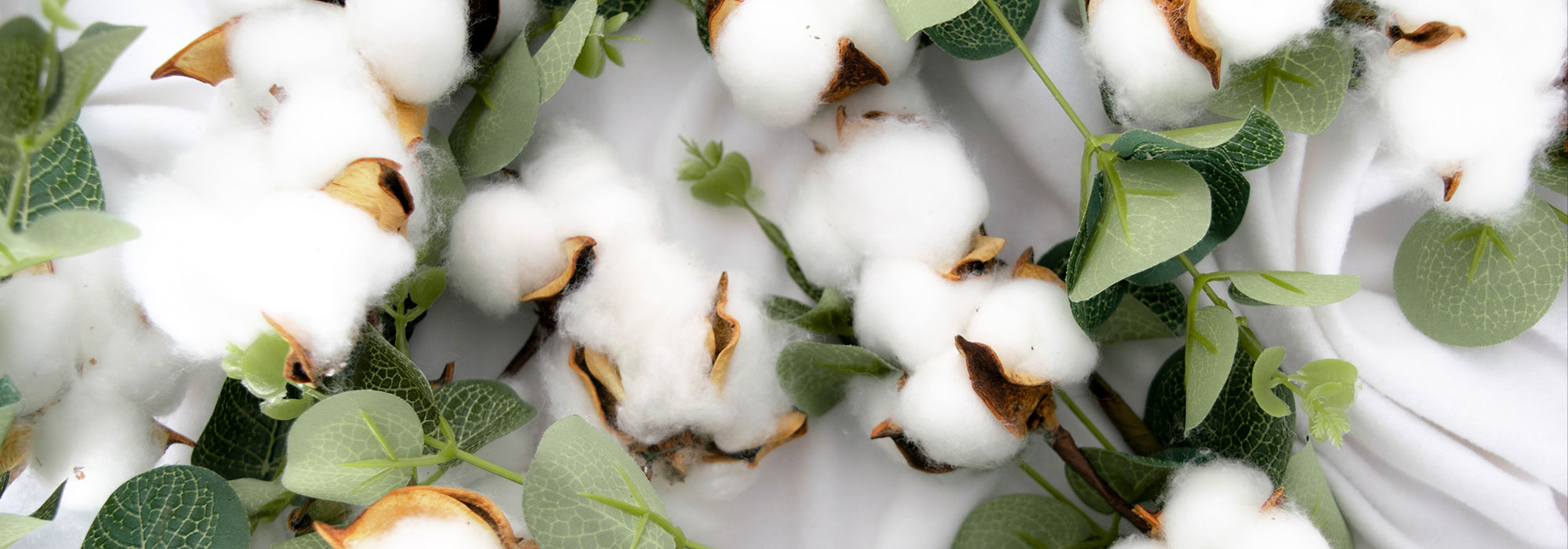Did you know? Cotton is the world’s biggest consumer of water: more than 10,000 litres of water are needed to produce just one pair of jeans! Furthermore, the cotton plant requires numerous treatments using insecticide and toxic fertiliser which damage soil.
However, cotton remains an extremely popular material in the texture industry and demand continues to rise. This makes farming the world’s biggest cause of pollution without accounting for the extremely difficult working conditions in fields.
To reduce the harmful impact of traditional cotton growing, encouraging initiatives will help foster a positive transformation over the coming years. This is the case for in-conversion cotton.
An alternative already exists: organic cotton! Regulated by strict standards, organic farming is more reasonable, with a much sounder environmental and social impact than traditional farming. Therefore organic cotton appears the obvious choice. And yet…
Today, just 1% of global cotton production is organic (a figure mentioned by Textile Exchange during COP26). And for good reason: to move from conventional farming to organic farming, farmers must enter a transition period which may last up to three years. During these three years, farmers will implement new management methods in order to clean up and restore soils by avoiding the use of toxic substances banned in organic farming. To ensure that rules are closely followed, farmers are audited by certification bodies.
And three years is a long time for a farmer who earns their living through cotton growing. Therefore beginning this transition is a difficult decision. During this long and limiting period, the cotton producer’s business is placed in jeopardy with yield loss and a drastic drop in revenue as well as complex organic certification processes.
With this in mind, KARIBAN BRANDS wanted to encourage and help these farmers during the transition period by signing up to a comprehensive support scheme. The transition to organic and more sustainable cotton growing is known as “in-conversion cotton“. Let’s explain.
What is in-conversion cotton?
This is simply the name of the cotton fibre transitioning from conventional farming to organic farming. To be clear: the cotton grown is certified in-conversion organic cotton.
Standards are strict, from the start of the conversion process. Ultimately, they are the same as for organic cotton, once the transition period is over. The specifications must be closely followed from the start of the process to achieve the end goal: the coveted organic certification.
- Once the process has begun, synthetic pesticides (insecticides, herbicides, etc.) and GMOs are restricted or even banned. The products used in organic farming are more favourable for soil health, people and ecosystems.
- At the same time, farmers are practising crop rotation, alternating various plants on the plots to promote the reasonable use of land resources and allow soils to regenerate. The result is efficient and sustainable production which encourages biodiversity without prematurely degrading soils.
- Also with the aim of saving precious resources, particular attention is paid to water. Taking care of land by alternating plants makes it naturally richer. As such, it retains more rainwater, reducing the amount of water needed to irrigate the plots. In addition, strict regulations on pesticide use mean that large amounts of water are no longer wasted on diluting them as is the case in conventional cotton growing.
- Finally, working conditions are also improved in in-conversion organic cotton growing. The use of natural fertilisers prevents producers from being exposed to toxic substances. This is a significant development as workers are not always provided with suitable protective gear in conventional cotton growing. Therefore breathing in chemical products has led to many chronic illnesses.
What is the difference between organic cotton and in-conversion cotton?
In-conversion or “in-transition” cotton meets organic standards: water savings, the banning or restriction of toxic chemical products, crop rotation and respect for workers.
The difference? This transition is just one step on the organic path, covering the famous three-year period – studied and required by organic standards, such as the GOTS 6.0 – which allows land to clear out all “harmful” substances used during conventional farming methods.
If these toxins are are not completely removed from these soils, farmers will not be awarded “organic cotton” certification. Furthermore, in the first year of transition, cotton will continue to be sold as conventional cotton. In the second and third years, it may be sold as in-conversion organic cotton.
In any event, cotton producers are assessed and audited throughout the conversion process to ensure that their practices follow the rules set out by certification bodies.
Consumer behaviour is also changing! More and more consumers are considering their environmental impact, including when purchasing their textiles. They are naturally turning to eco-friendly materials, produced and grown with more responsible and regulated methods. Organic cotton is one of the most popular materials with demand forecasts increasing steadily for the coming years.
The snag? It is relatively expensive with rising prices over recent months, largely because demand exceeds supply!
In-conversion organic cotton is an attractive solution to offset organic cotton supply issues while continuing to offer a sustainable alternative to conventional cotton.
Furthermore, Kariban has developed a range of t-shirts for men, women and children in in-conversion organic cotton. Recognising them is simple: these styles end with the letters “IC” for “In-Conversion”. In terms of comfort, sustainability, colour rendering and printing options, in-conversion cotton is a worthy rival to certified organic cotton.
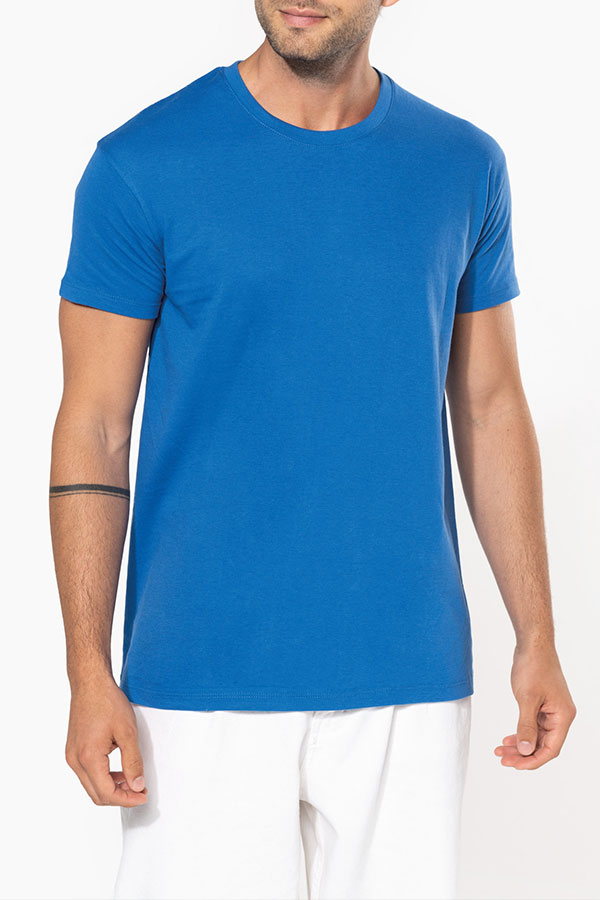
K3025IC
Men's Organic 150IC crew neck t-shirt

K3026IC
Women’s Organic 150IC crew neck t-shirt
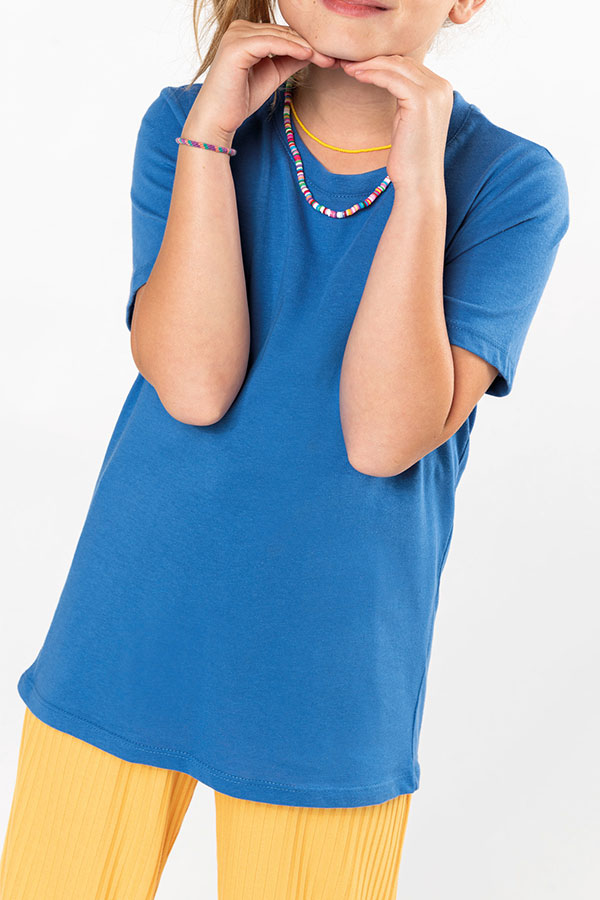
K3027IC
Children’s Organic 150IC crew neck t-shirt
In short, in-conversion cotton is not a substitute for organic cotton but a way for farmers to begin their organic journey while receiving help and support along the way. The conversion process is far from restful for producers.
A long and costly process for farmers
There is a reason why just 1% of global cotton production is organic: the certification process is long and costly with very strict standards. Therefore, few farms are able to take this decision due to the risk of losing their livelihoods. Why?
-
And a farmer who enters the in-conversion cotton business must change their farming methods almost “overnight”. Plants, crops, maintenance, irrigation and production: every link in the chain must be corrected and optimised to meet organic standards. As well as being a substantial human and financial investment, it has repercussions on plot yield.
-
Land used to synthetic fertilisers goes into a “withdrawal” state when they are no longer applied. Therefore, this land is less productive during the transition period, leading to a direct loss of profits for the farms.
-
In addition, during the three transition years, an in-conversion cotton farm cannot sell its product at the same price as certified organic cotton. As such, they cannot offset the lost yield and investments incurred by organic requirements with an increased sales price.
The farmers need support, particularly financial, to be able to sustainably change their practices. This is why KARIBAN BRANDS is taking part in the “In-Conversion” programme in order to contribute to this positive shared objective: encouraging increasingly sustainable farming while continuing to provide our customers with high-quality products!
Organic cotton is good but GOTS (Global Organic Textile Standard) cotton is even better!
Organic cotton is grown without the use of synthetic pesticides (such as insecticides), herbicides or GMOs (Genetically Modified Organisms). This is already a giant step forward! But this virtuous impact can be further maximised throughout the chain: from growing to manufacturing and distribution, ensuring that all steps and stakeholders are committed to sustainable practices.
This is implied by GOTS (Global Organic Textile Standard), the most complete and exacting certification on the market. As it stands, it is also the only means of certifying organic cotton which is grown and marketed with sustainable and harmless practices, for soils, workers and consumers.
Quality, traceability and sustainability are thus guaranteed by totally independent certification bodies (such as Ecocert) which ensure that the standards required to achieve the highly coveted GOTS (Global Organic Textile Standard) certification are met.
The following important points are assessed and monitored by certification bodies to award a fabric with GOTS (Global Organic Textile Standard) certification:
The composition of finished products
Two possibilities :
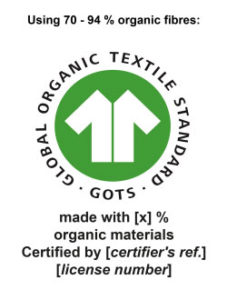 |
A textile product bearing the GOTS (Global Organic Textile Standard) “made with X% organic materials” label must contain at least 70% certified organic or in-conversion organic fibres. |
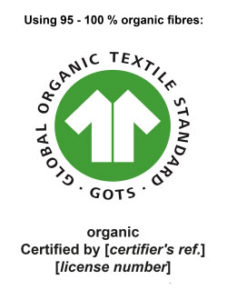 |
While a textile product bearing the GOTS (Global Organic Textile Standard) organic label must contain at least 95% certified organic or in-conversion organic fibres. |
The fibres used
As discussed above, organic fibres are grown without synthetic pesticides, GMOs or herbicides. These practices are an inherent part of GOTS (Global Organic Textile Standard) certification, however they are regulated by organic farming standards.
“Water consumption
“
Water must be consciously used in a reasonable manner, especially during periods of drought where irrigation must be appropriate and carried out “manually” to minimise waste.
Management of activity-generated waste and by-product
The amount of waste generated as well as the treatment of this waste and and waste water are also governed by GOTS (Global Organic Textile Standard).
Packaging and components other than the textile itself
Product accessories, cardboard and paper packaging and tags on textile items must be recycled or labelled (e.g. FSC).
Working conditions
The GOTS (Global Organic Textile Standard) social criteria must be followed by all stakeholders (transformers, manufacturers and sellers) and are based on:
- the International Labour Organization (ILO) standards
- the United Nations Guiding Principles on Business and Human Rights (UNGP)
- and the principles of the Organisation for Economic Co-operation and Development (OECD)
These criteria recall, inter alia, that child labour and discrimination are prohibited, that the job must be freely chosen and that employees must enjoy the mandatory basics of Occupational Safety and Health (OSH).
Quality assurance of products made with cotton
Tests performed in independent laboratories must be presented to the certification body during the test audits. These long and costly analyses are absolutely essential to prove that the cotton fibres are free of chemical substances.
Quality is as important as impact for Kariban, therefore in-conversion organic cotton items are both transitioning towards organic cotton AND GOTS (Global Organic Textile Standard) certified!
Moving together towards more sustainable farming
Therefore, the aim of this in-conversion farmer support programme is to make practical changes. With global environmental awareness and the shared desire for more sustainable garments, we must find solutions that encourage eco-friendly practices.
This is what KARIBAN BRANDS saw in in-conversion organic cotton: a useful approach to offer quality textiles produced sustainably and reasonably.
This programme offers genuine support to cotton producers transitioning to organic, and also benefits communities around the farms, direct customers and end consumers. Fewer toxic products and more alternatives to conventional cotton: an effective response to the growing demand for more sustainable textiles, without jeopardising the health of residents around the farms!
This multi-faceted impact is fully in line with KARIBAN BRANDS’ prized global responsible company approach.
Farmers have a means of recourse, allowing them to “keep going” during their transition period by being compensated for their efforts, and more and more cotton is grown organically.
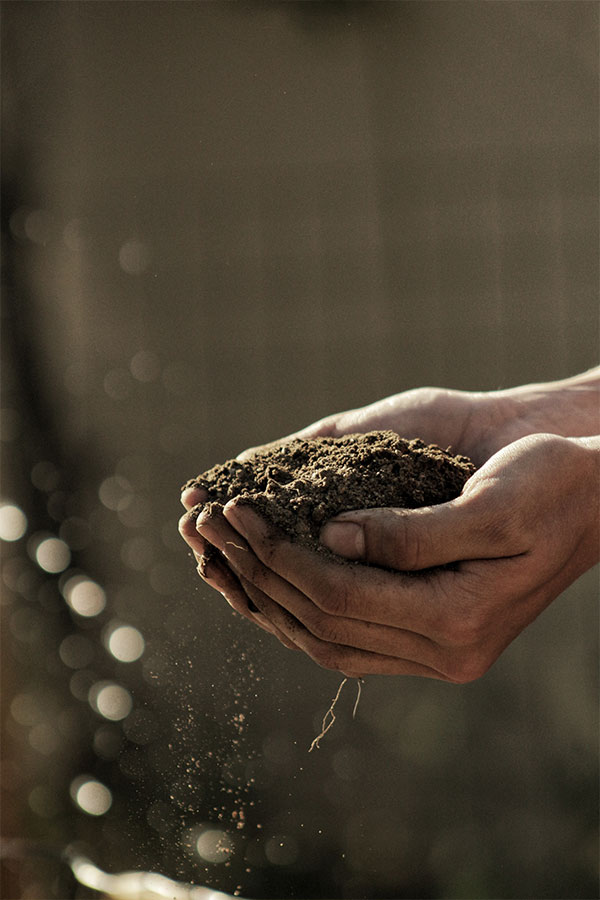
Conventional farming will be phased out, organic cotton supply will improve for brands and it will become easier to find truly sustainable cotton given the growing consumer demand.
Ultimately, organic cotton will be put to best use, be more appealing, and prices will balance out, allowing more customers to access high-quality, sustainable textiles.
At both TopTex and KARIBAN BRANDS, committed and enthusiastic teams make every effort to find and contribute to innovative solutions. The most important thing is to focus our efforts on tangible, transparent, verifiable and truly impactful approaches.
KARIBAN BRANDS will therefore continue to prioritise in-conversion cotton in more ranges in order to support the positive transformation we all aspire to.
Year after year, KARIBAN BRANDS works to challenge the status quo and question its manufacturing and distribution processes in order to further reduce our impact on the earth and its resources which are so precious to all of us.
That’s right – to be textile agents and agents of change!


